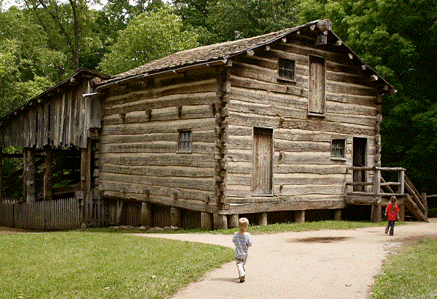ILLINOIS WINDMILLS
Dedicated to the history, preservation, and continuing story of windmills in Illinois.

Samuel Hill Carding Mill
Lincoln's New Salem State Historic Site
15588 History Ln
Petersburg, IL 62675
Status
Operational
Tours
Tours are available during open hours. Visit their website for current pricing and operating information; the mill operates only occasionally.
Hours
March 1 to April 15
Wednesday - Sunday: 9:00 A.M. to 5:00 P.M.
April 16 to September 15
Sunday - Saturday: 9:00 A.M. to 5:00 P.M.
September 16 - October 31
Wednesday - Sunday: 9:00 A.M. to 5:00 P.M.
November 1 - February 28 / 29
Wednesday - Sunday: 8:00 A.M. to 4:00 P.M.
Website
Uses
(1835 - 1840's) Carding wool
(1932 - present) Carding wool and museum
Constructed
(1835) Original
(1840) Relocated
(1932) Reconstructed
Millwrights
Samuel Hill (original)
Civil Conservation Corps (reconstruction)
Owners
Samuel Hill (1835 - 1837)
Hardin Bale (1837 - ?)
State of Illinois (1932 - present)
Sources
-
Lincoln’s New Salem Historic Site: www.lincolnsnewsalem.com
-
Illinois Historic Preservation Agency: http://www.state.il.us/HPA/hs/new_salem.htm
-
National Park Service, U.S. Department of the Interior

The Samuel Hill Carding Mill.
Photo from Wikimedia Commons
History of the Mill
At the site of Lincoln’s New Salem settlement stands a working replica of an animal-powered mill for spinning wool into fabric. Although the machine is not original, it is the only one of its kind in the country, and one of just three in the world. President Abraham Lincoln, for whom the site is named, lived in the village between 1831 and 1837.
The original village of New Salem, Illinois was platted in 1829. It was situated along the Sangamon River, an important source of power and trade during that time. It was along this river that mills were built, including a water-powered grist mill (which is also present in the new village, but not operational). Samuel Hill, a prominent resident of New Salem, began plans to construct a carding mill so that it would ease the pioneers’ ability to spin fabric from wool. In fact, Hill was the postmaster of New Salem until he gave the job to Lincoln.
Because the mill was situated near his house, however, the mill could not be run by the waters of the Sangamon River. Instead, an animal-driven mill was constructed. Unlike some animal mills in which horses or oxen were hitched to a harness that turned a rotating shaft, Hill’s mill required oxen to walk upon a 40’ wooden turntable. The oxen would remain stationary as their legs turned the giant wheel to power the mill.
A shaft (similar to the wind shaft on a windmill) ran from the cogged teeth underneath the turntable to the spur wheel to drive the machinery within the mill. The most important piece of machinery was the carding machine, which was responsible for stretching and combing the wool fibers to create fabric. Different parts of this machine can be operated independently and through a series of old-fashioned leather belts.
Hill opened the mill in 1835. Similar to grist mills, Hill received payment either in cash or by keeping 20% of the final product. Hill ran the mill along with his apprentice, Hardin Bale. Not long after Lincoln left New Salem, many people began moving on to other settlements. Hill sold the mill to Bale in 1837. Around 1840, Bale relocated the mill to Petersburg, Illinois. Eventually the mill fell into disuse and was destroyed. By the late 1840s, New Salem completely abandoned.
New Salem Historical Village is only part of the much larger New Salem Park, which is now over 700 acres. When it was first established, William Randolph Hearst pushed for the purchase of the land so that New Salem could be reconstructed. On April 3, 1919, the sale of 82 acres was approved. Over the next several years, a great amount of research was dedicated to creating an historically accurate plan of New Salem, its buildings, people, and culture. Reconstruction of the village began in 1932. All of the log cabin-style buildings were reconstructed from scratch, except for the cooper store. The store was moved to Petersburg when the town was abandoned, but the building survived and was brought back to New Salem.
New Salem State Historic Park is open year-round. There are also camping sites, trails, canoeing and kayaking. An estimated 450,000 people visit the park annually.